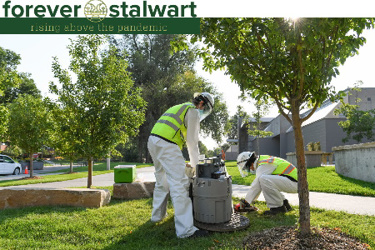CSU Delivers COVID Wastewater Testing Data To State Health Officials And Wastewater Partners

Twice a week for months, Colorado State University has been testing wastewater samples from 21 locations around the state for SARS-CoV-2, the virus that causes COVID-19. The diligent team of researchers turns around the results within 24 hours, and health officials and wastewater partners can immediately access this timely data through a dashboard created by CSU.
Turnaround time is critical because a spike in viral particles in wastewater can indicate an approaching surge in COVID cases and hospitalizations. Having this type of early warning system in place can alert health officials in advance and give the state more time to allocate resources where they’re needed most.
“Now that we have all these data behind us, the decision-makers can have increasing confidence in the value of the data and use it to help make decisions,” said Susan De Long, associate professor in the CSU Department of Civil and Environmental Engineering who co-leads lab analysis with Carol Wilusz, a professor and RNA biologist in the Department of Microbiology, Immunology and Pathology. “That’s the whole point – to use the data to help make decisions to keep us safe.”
The Colorado Department of Public Health and Environment funded the wastewater monitoring project that covers 52% of Colorado’s population. In the first few months of the program, the agency has been focused on building capacity and refining procedures.
“We are looking at the data to help us understand how prevalent COVID-19 is in Colorado,” said Allison Wheeler, an epidemiologist with the Colorado Department of Public Health and Environment. “As we collect more data, we hope to begin to analyze trends within communities.”
In addition to serving as an early warning system, the data could expose limitations in the state’s other disease monitoring efforts, Wheeler said.
Public dashboard
Using the data from CSU, the Colorado Department of Public Health and Environment has created a public dashboard, so citizens can view wastewater testing results for participating wastewater districts, along with the number of cases reported in each area. CDPHE cautions against comparing wastewater service areas to one another, because wastewater composition varies from system to system.
“This is an emerging science and we’re learning daily,” Wheeler said. “We will continue to update protocols and measures reported and displayed on the dashboard, as necessary, to provide the best information possible to the citizens of Colorado.”
Poop proves useful in tracking COVID, preventing outbreaks
Tyler Wible and Matthew Korsa at the One Water Solutions Institute, under the supervision of CSU Professor Mazdak Arabi, created the stakeholder dashboard to communicate data to project participants and as a tool for active research and data analysis. CSU researchers are impressed with the strong correlation between SARS-CoV-2 levels in wastewater and case data.
“The data indicate a significant correlation between SARS-CoV-2 levels in wastewater streams and new cases within the facility sewersheds,” Arabi said. “The strength of the correlation holds in small and large facilities across regions along Colorado’s Front Range. These findings indicate that monitoring wastewater SARS-CoV-2 levels can serve as a complementary tool to prepare for combating community spread of COVID-19.”
Wilusz credits CSU’s proactive approach combining wastewater surveillance and individual testing through nasal swabs and saliva screening for preventing the spike in cases seen in other university towns when students returned in the fall.
“We made sure CSU was not responsible for the peak that happened. That peak happened almost entirely after the students left,” Wilusz said, referring to a spike in Larimer County cases following fall break, when all classes moved online.
Pandemic and wastewater collection continue
Over holidays and in all sorts of weather, the sampling and lab technicians working with De Long and Wilusz – many of them students – collect samples on campus and analyze the results. On one collection day, the crew worked 12 hours during a snowstorm.
“They have an important job, and they have been working their butts off,” Wilusz said.
Statewide wastewater sampling and testing will continue at least through the end of July, when CSU’s contract with CDPHE ends. As more people are vaccinated and the pandemic eases up, wastewater testing will continue to be important.
“Once the level goes down, it might actually be more valuable to continue monitoring, so if there are any escaping mutations from the vaccine, we’ll be able to detect those early and jump on them,” Wilusz said.
Wastewater testing has proven to be useful as a piece of the puzzle in the overall pandemic response, allowing for a more targeted approach.
“Part of the reason for monitoring different communities separately is so we don’t have to just have statewide policies; we can focus on where problems are and get those problems under control,” De Long said. “It’s information that helps us be strategic and keep people safe.”
Source: Colorado State University
